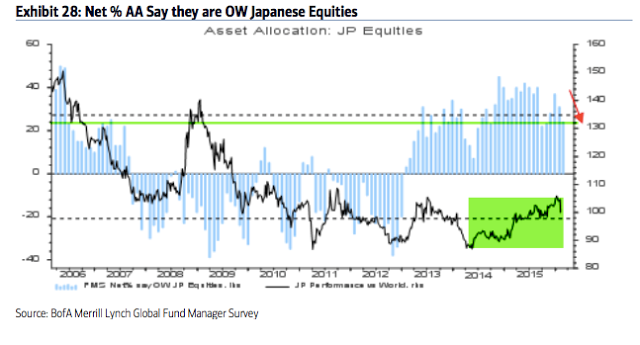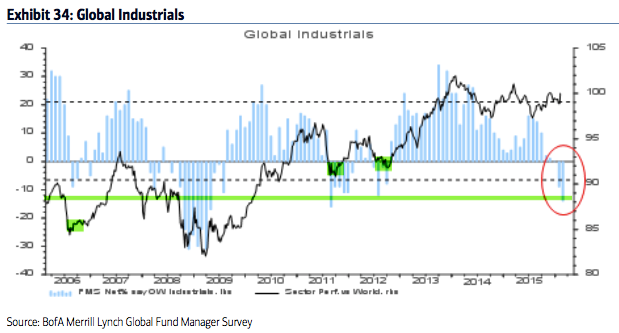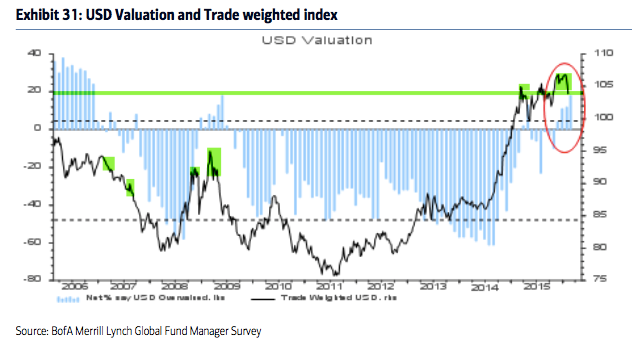Summary: Fund managers' cash in February rose to the highest level since 2001, higher than at any time during the 2008-09 bear market. This is bullish for equities.
In the past two months, global allocations to equities have fallen from 40% overweight to just 5%. Since 2009, allocations have only been lower in mid-2011 and mid-2012, periods which were notable lows for equity prices during this bull market. This is bullish for equities.
Allocations to US equities remain at an 8 year low, a level from which the US should continue to outperform, as it has during the past 10 months. Europe remains very overweight. Emerging markets were the only region that saw an increase in exposure; it is still very underweighted and the region's recent outperformance should continue.
Among sectors, exposure to industrials fell to the lowest level since August 2011 and banks to the lowest level since December 2012. Among defensive sectors, allocation to utilities is now the highest since September 2011. From a contrarian perspective, some cyclical sectors may be set up to outperform defensives.
The dollar is considered to be the most overvalued in the past 9 years. Under similar conditions, the dollar has fallen in value.
* * *
Among the various ways of measuring investor sentiment, the BAML survey of global fund managers is one of the better as the results reflect how managers are allocated in various asset classes. These managers oversee a combined $600b in assets.
The data should be viewed mostly from a contrarian perspective; that is, when equities fall in price, allocations to cash go higher and allocations to equities go lower as investors become bearish, setting up a buy signal. When prices rise, the opposite occurs, setting up a sell signal. We did a recap of this pattern in December 2014 (here).
Let's review the highlights from the past month.
Cash: Fund managers cash levels jumped to 5.6%, the highest since the post-9/11 panic in November 2001, and lower than at any time during the 2008-09 bear market. This is extraordinary. Current levels are an extreme that is normally very bullish for equities. Even November 2001, which wasn't a bear market low, saw equities rise nearly 10% in the following 2 months.

Global equities: Fund managers are just +5% overweight equities, a huge drop from +42% overweight in December (which was near a 7-month high). Equity allocations since 2009 have only been lower in mid-2011 and mid-2012, periods which were notable lows for equity prices during this bull market.

US equities: US exposure remains at an 8 year low (-19% underweight). Despite low exposure, US equities have outperformed the past 10 months. US equities have been under-owned and should continue to outperform those in Europe and Japan on a relative basis (see below).

European equities: Eurozone exposure (+36% overweight) fell hard from the highest allocation levels in 8 years in recent months. Current allocations are still almost a standard deviation above the mean, making European equities at risk of continuing to underperform. 
Japanese equities: Allocations to Japan dropped to +24% overweight, which is still 0.7 standard deviations above the long term mean. The region has been outperforming since early 2014.

Emerging markets equities: Emerging markets were the only region to see an increase in exposure this month (to -23% underweight). In January, allocations had fallen to the second lowest in the survey's history, an extreme comparable only to early 2014 from which the region began to strongly outperform for the next half a year. Emerging markets have recently started to outperform again. There should be more upside, as allocations remain 1.8 standard deviations below the long term mean.

Global bonds: Fund managers are -36% underweight bonds, a big rise from -64% underweight in December, which was a 2-year low. Current allocations are the highest since November 2012. Note that bonds have outperformed in the past 10 months. Also note that bonds have started to underperform when allocations rise to -20% underweight.

The drop in equity allocations and the outperformance of bonds come as fund managers have become less optimistic about the global economy. 16% expect a weaker economy in the next 12 months, the lowest since December 2011.

Commodities: Allocations to commodities remain near one of the lowest levels in the survey's history (-29% underweight). This is 1.6 standard deviations below the long term mean. The low allocation to commodities goes together with pessimism towards the global economy and emerging markets.

Sectors: Relative to history, managers are overweight cash, utilities, the dollar as well as some high beta sectors (discretionary, tech). They are more overweight bonds than equities and underweight industrials. Overall, this is defensive positioning.
Fund managers' allocation to banks was among the largest ever in December; this has now fallen to the lowest allocation since December 2012, the month from which banks started to consistently underperform. 
Fund managers' allocation to industrials fell to the lowest level since August-2011 (1.6 standard deviations below the mean). From a contrarian perspective, the sector may be set up to outperform. 
Fund managers' allocation to utilities rose to the highest level since September-2011 (1.3 standard deviations above the mean). From a contrarian perspective, the sector may be set up to underperform.
Dollar: Since 2006, fund managers surveyed by BAML has been very good at determining when the dollar is overvalued. In March 2015, they viewed it as overvalued for the first since 2009; the dollar index fell from 100 to 93 in the next two months. They again view the dollar as overvalued (the highest since November 2006) and the index has recently turned lower. Similar cases are highlighted in green.
Survey details are below.
- Cash (5.6%): Cash balances increased to 5.6% from 5.4%; this is the highest since November 2001. July and September (5.5%) were the highest cash levels since December 2008. Typical range is 3.5-5%. BAML has a 4.5% contrarian buy level but we consider over 5% to be a better signal. More on this indicator here.
- Equities (+5%): A net +5% are overweight global equities, a sharp drop from +42% in December and +21% in January. Over +50% is bearish. A washout low (bullish) would be under +15%. More on this indicator here.
- Regions:
- US (-19%): Exposure to the US fell back to -19% underweight, the same as in December, which was an 8 year low.
- Europe (+36%): Exposure to Europe fell hard to +36% overweight from +51% overweight in January.
- Japan (+24%): Exposure to Japan fell to +24% overweight from +31% in January. Funds were -20% underweight in December 2012 when the Japanese rally began.
- EM (-23%): Exposure to EM rose to -23% underweight from -33% underweight in January. It was -34% underweight in September, the lowest in the survey's history.
- Bonds (-36%): A net -36% are underweight bonds, a rise from -64% in December and -47% in January. Note that global bonds started to underperform in mid-2010, 2011 and 2012 when they reached -20% underweight.
- Commodities (-29%): A net -29% are underweight commodities, a small drop from -30% last month. Low commodity exposure goes in hand with low sentiment towards EM.
- Macro: 16% expect a weaker global economy over the next 12 months, the most pessimistic since December 2011.
Which stock should you buy in your very next trade?
AI computing powers are changing the stock market. Investing.com's ProPicks AI includes 6 winning stock portfolios chosen by our advanced AI. In 2024 alone, ProPicks AI identified 2 stocks that surged over 150%, 4 additional stocks that leaped over 30%, and 3 more that climbed over 25%. Which stock will be the next to soar?
Unlock ProPicks AI


